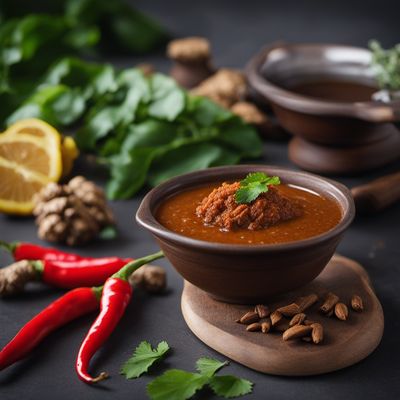
Dish
Puli inji
Tamarind and ginger chutney
Puli inji is made by cooking tamarind with ginger, jaggery, and spices such as cumin and mustard seeds. The mixture is then blended to a smooth consistency. The chutney has a tangy and spicy flavor that pairs well with rice and curry dishes. It is also a good source of antioxidants and anti-inflammatory compounds. Puli inji can be stored in the refrigerator for up to a week.
Origins and history
Puli inji is a traditional condiment in Kerala, a state in South India. It is often served with rice and sambar, a lentil-based vegetable stew. Puli inji is also a common accompaniment to dosas and idlis.
Dietary considerations
Vegan, gluten-free
Variations
Puli inji can be made with different types of chili peppers to adjust the level of spiciness. Some recipes call for the addition of garlic or curry leaves to add flavor. Others use different types of sweeteners such as honey or sugar.
Presentation and garnishing
Puli inji can be presented in a small bowl or jar, garnished with fresh herbs such as cilantro or mint. It can also be served alongside other chutneys and dips for a colorful and flavorful spread.
Tips & Tricks
To make puli inji milder, use fewer chili peppers or remove the seeds. To make it spicier, add more chili peppers or red pepper flakes. Adjust the consistency by adding more tamarind or water as needed.
Side-dishes
Puli inji can be served with a variety of South Indian dishes, including rice and sambar, dosas, and idlis. It can also be used as a spread on sandwiches or as a dip for vegetables.
Drink pairings
Pair puli inji with a refreshing drink such as a coconut water or a glass of buttermilk.
Delicious Puli inji recipes
More dishes from this category... Browse all »

Ajika
Georgian cuisine

Almond Chutney
Indian cuisine

Amba
Middle Eastern cuisine

Amrood ki chutney
Indian cuisine

Anchoïade
French cuisine

Avocado Chutney
Indian cuisine

Baba ghanoush
Middle Eastern cuisine

Bagna càuda
Italian cuisine
More cuisines from this region...

East Indian cuisine
Spicy and tangy flavors, Uses a lot of herbs and spices (mustard seeds, cumin, coriander), Uses a lot of fish and seafood which give it a unique flavor

North East Indian cuisine
Spicy, Tangy, Flavorful, Unique

North Indian cuisine
Spicy, Tangy, Aromatic, Sweet, Uses a lot of oil and ghee

Other Indian cuisine
Spicy, Tangy, Sweet, Sour, Pungent

South Indian cuisine
Spicy, Tangy, Sweet, Savory, Aromatic

West Indian cuisine
Spicy, Bold, Tangy, Sweet, Savory

